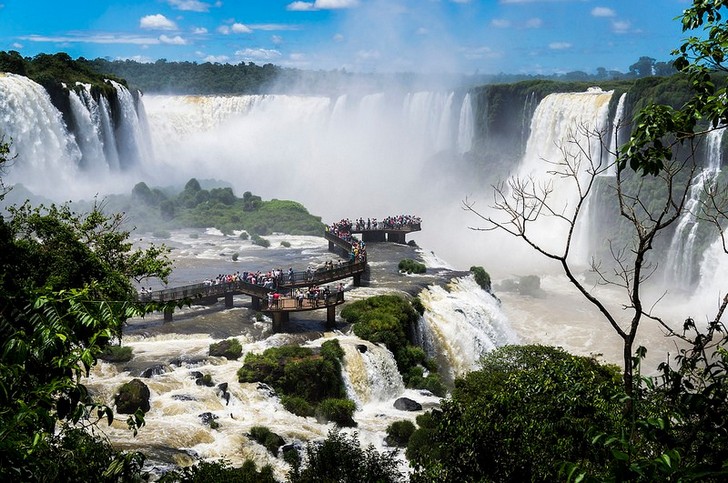Cultural and historical sights of the cities of Brazil
In the former capital and main tourist city of Brazil, Rio de Janeiro, there are the most famous sights: the Statue of Christ the Redeemer, Sugarloaf mountain, Sambodrome – the unofficial symbol of Rio. Cathedrals and churches, palaces, the main theater of the city, the National Library and other significant places deserve no less attention.
Sao Paulo is the largest Brazilian metropolis with skyscrapers and extraordinary architectural objects, including Oscar Niemeyer’s Edificio Copan residential building. The city has the best theater venue in the country – the Municipal Theater of São Paulo.

The beautiful theater building was created not without the influence of Parisian architecture; it is located very conveniently – in the area of the historical center. The indoor municipal market is a landmark place: always a busy outlet, and the building itself is a recognizable landmark. An oasis of nature is the architecturally designed park of Ibirapuera, a favorite vacation spot for citizens.
The main attractions of the capital, the city of Brasilia, are the grandiose and unusual in design administrative buildings on the Square of the Three Powers – the National Congress, the Supreme Tribunal and the Planalto Palace. Even more impressive is the Cathedral of the Blessed Virgin Mary, made in the style of modernism.
Ouru Preto is a city-museum under the open sky, included in the UNESCO World Heritage List. Almost every building on its streets is an architectural monument in the Baroque style, and the main decoration and hallmark of the city is the Cathedral of St. Francis.
The symbol of the large commercial and tourist city of Fortaleza in the north-east of the country is the Dutch Fort of the Assumption of Our Lady, the territory of which can only be accessed as part of pre-booked excursions.
Natural attractions of Brazil
The nature of Brazil defies verbal description. There are more than 60 national parks and reserves in the country.
One of the main natural wonders of Brazil is the Iguazu Falls complex, which includes about 270 cascades. The park’s most famous waterfall is the Devil’s Throat, which is shaped like a horseshoe. Viewing platforms are equipped for tourists. The waterfalls are one of the most visited natural attractions in Brazil.
Quite different views open up in the Pantanal Nature Reserve, covering the territory of the swampy lowlands of the Paraguay River. This is a popular place for eco-tourism, the most attractive for nature photographers, since the flora and fauna of the park is very diverse. Like the waterfalls, the park is a UNESCO World Heritage Site.
The abrupt change of scenery surprises visitors to the Park of the Dunes, located in the vicinity of Natal. On the golden sand dunes you can ride in jeeps or buggies.
Waterfall “Devil’s Throat”
Without a doubt, the main attraction of Iguazu Falls is the “Devil’s Throat”, the most publicized horseshoe-shaped Iguazu Falls, 82 meters high and 150 meters wide, which runs right in the middle of the border between Argentina and Brazil. In total, there are 14 powerful streams that fall on the ground with a wild roar.

The force of the falling water is so great that there is always a halo of spray around the waterfall. Water comes here from three sides at once. On the bridge you can go almost to the very heart of this whirlpool, naturally get wet along the way and admire its proximity.
Very well thought out – tourists walk almost inside this water basin, choking with delight! Here the volcanic origin of the waterfalls becomes clear – as a result of a volcanic eruption, this giant crevice appeared in the ground. The Devil’s Throat is, of course, the grandest spectacle of unforgettable beauty, amazing!
The Brazilian part of the Throat bears the poetic name Salto Floriano, which means Leap of Flowers. After inspecting the Devil’s Throat, you can take the elevator upstairs and finish the tour of the park.
On the territory of the park, visitors are greeted by funny nosokha animals, begging for food and not at all afraid of contact with people. Feeding them is not recommended, but everyone is fed anyway, so when visiting the park, it’s a good idea to stock up on chips.
The best time to visit the waterfalls is traditionally considered the months from December to March, characterized by intense heat and heavy rains. Waterfalls during this period have the largest volume of water and look extremely impressive.
Despite this, it should be borne in mind that frequent heavy rains during this period can disrupt your plans. During the dry period from April to September, comfortable weather sets in here without sweltering heat and rain, and, according to many, this period is the most suitable for visiting the waterfalls.
